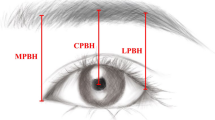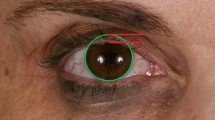Abstract
Background
Oriental blepharoplasty is the most frequently performed aesthetic surgery among far east Asians (i.e., Korean, Chinese, Japanese, and Taiwanese). Numerous studies on oriental blepharoplasty have been published, but only a few, if any, have reported on the measurable effects of such surgeries on the upper face. To scientifically evaluate the changes in the upper face of young Korean adults after oriental blepharoplasty, a periocular morphometry study was conducted.
Methods
A retrospective image analysis was used to identify the changes in the upper face after oriental blepharoplasty. Preoperative and postoperative digital facial images of 612 patients (598 women and 14 men) who underwent oriental blepharoplasty were examined. The height of the palpebral fissure (HPF), the distance between the highest point of the palpebral fissure of the upper eyelid and the eyebrow (DEE), and the distance between the eyebrow and the hairline (DEH) were measured to analyze the effects of oriental blepharoplasty in the upper face.
Results
After oriental blepharoplasty, the HPF and DEH increased in length by 11.8 and 4.9 %, respectively, and the DEE decreased in length by 14.0 %. Patients who originally did not possess double eyelids showed greater changes than those who originally did possess such eyelids. Such changes were characterized by a significant inverse correlation between the DEE and DEH. In addition, when postoperative changes were measured before and after 6 months, the palpebral fissure and forehead showed an even greater increase.
Conclusions
Oriental blepharoplasty can induce substantial changes in the proportions of the upper face. It can not only increase the size of the eyes, but also induce changes in eyebrow position resulting in a more refreshed appearance.
Level of Evidence IV
This journal requires that authors assign a level of evidence to each article. For a full description of these Evidence-Based Medicine ratings, please refer to the Table of Contents or the online Instructions to Authors www.springer.com/00266.




Similar content being viewed by others
References
Kang JS (2006) Plastic surgery, 3rd edn. Koonja Publishing, Inc, Seoul
Baek BS, Baek DH, Nahai F (2009) Cosmetic and reconstructive oculoplastic surgery, 3rd edn. Koonja Publishing, Inc, Seoul
Nahai F (2005) The art of aesthetic surgery: principles and techniques. Quality Medical Publishing, Inc., St.Louis
Starck WJ, Griffin JE Jr, Epker BN (1996) Objective evaluation of the eyelids and eyebrows after blepharoplasty. J Oral Maxillofac Surg 54:297–302 discussion 302–303
Gentile RD (2005) Upper lid blepharoplasty. Facial Plast Surg Clin North Am 13:511–524
Flowers RS, Caputy GG, Flowers SS (1993) The biomechanics of brow and frontalis function and its effect on blepharoplasty. Clin Plast Surg 20:255–268
Troilius C (2004) Subperiosteal brow lifts without fixation. Plast Reconstr Surg 114:1595–1603 discussion 1604–1605
Flowers RS, Flowers SS (1993) Diagnosing photographic distortion. Decoding true postoperative contour after eyelid surgery. Clin Plast Surg 20:387–392
Flowers RS, Flowers SS (1993) Precision planning in blepharoplasty. The importance of preoperative mapping. Clin Plast Surg 20:303–310
Ellenbogen R (1983) Transcoronal eyebrow lift with concomitant upper blepharoplasty. Plast Reconstr Surg 71:490–499
Burroughs JR, Bearden WH, Anderson RL, McCann JD (2006) Internal brow elevation at blepharoplasty. Arch Facial Plast Surg 8:36–41
Acknowledgments
Patients provided written consent for the use of their images.
Disclosure
The author has no financial interest to declare in relation to the content of this article. No outside funding was received.
Author information
Authors and Affiliations
Corresponding author
Rights and permissions
About this article
Cite this article
Kim, S.S. Effects in the Upper Face of Far East Asians After Oriental Blepharoplasty: A Scientific Perspective on Why Oriental Blepharoplasty is Essential. Aesth Plast Surg 37, 863–868 (2013). https://doi.org/10.1007/s00266-012-9994-y
Received:
Accepted:
Published:
Issue Date:
DOI: https://doi.org/10.1007/s00266-012-9994-y




